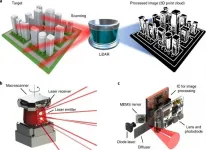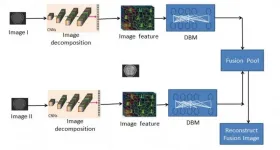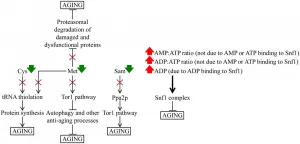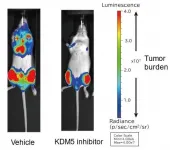(Press-News.org) In patients receiving therapeutic hypothermia after suffering out-of-hospital cardiac arrest, those who were cooled below 31 degrees Celsius (about 88 degrees Fahrenheit) for 24 hours showed no difference in terms of death or poor neurological outcomes at six months compared with patients receiving guideline-recommended cooling of 34 C (about 93 F). These findings are part of a study presented at the American College of Cardiology's 70th Annual Scientific Session.
Therapeutic hypothermia is a procedure in which a person's body is cooled far below normal body temperature. It has been shown to improve survival and reduce brain damage in people who have been resuscitated but remain comatose after suffering cardiac arrest (when the heart stops pumping effectively). Current guidelines for therapeutic hypothermia recommend cooling the body to 32-36 C for 24 hours. The new study found no benefit from a deeper cooling to 31 C.
"The results of our trial do not support the use of moderate therapeutic hypothermia of 31 C to improve neurological outcomes in comatose survivors of out-of-hospital cardiac arrest," said Michel R. Le May, MD, interventional cardiologist at the University of Ottawa Heart Institute and the study's lead author. "These findings do not support changing the current guidelines; we need to look for other strategies that can improve outcomes for these patients who currently have a poor prognosis."
The trial enrolled 367 patients treated for out-of-hospital cardiac arrest at the University of Ottawa Heart Institute between 2013-2020. All patients had been successfully resuscitated, as indicated by a return of blood pressure, but remained comatose. Participants were cooled with an endovascular device that uses temperature-controlled saline-filled balloons inserted near the heart via a vein to alter a patient's body temperature. For half of the patients, the endovascular device was set to cool the body to 31 C and for the other half the device was set to 34 C. Once the target temperature was achieved, the temperature was maintained for 24 hours before the patient was warmed up to normal body temperature at a rate of 0.25 degrees per hour.
The trial is the first to use a randomized, double-blind approach for testing different target temperatures for therapeutic hypothermia. Physicians overseeing the treatment were prevented from seeing the temperature setting by a shield placed over the temperature display on the endovascular machine. Nurses were aware of the temperatures but maintained separate charts to maintain blinding among the treating physicians.
The study's primary endpoint, a composite of death or poor neurological outcome at six months, occurred in 48% of those cooled to 31 C and 45% of those cooled to 34 C, a difference that was not statistically significant. There was also no significant difference between groups in terms of the rate of death or the rate of poor neurological outcome when these outcomes were assessed individually. The researchers examined outcomes by sex, age and other variables but found no significant differences in any subgroups analyzed.
Patients cooled to 31 C on average had a longer stay in the cardiac intensive care unit, which Le May said may reflect the fact that both the cool-down and warm-up periods lasted longer for these patients due to the lower target temperature.
Other researchers have assessed whether different temperatures or durations of therapeutic hypothermia can improve outcomes, but these previous studies have similarly demonstrated no improvement over current guidelines. Moving forward, Le May suggested brain monitoring approaches could be used to inform which strategies may be best suited for each patient's particular situation.
"It may be useful to pool all these studies together and try to figure out if there is a particular temperature that's more suitable in particular cases," Le May said. "We also have to find better, noninvasive tools to assess the brain and perhaps turn our attention toward a more personalized way of treating these patients. This would allow us to select the protocol that optimizes the benefit for a particular patient."
Le May said that many key elements influencing survival after out-of-hospital cardiac arrest come into play before the patient reaches the hospital, including whether bystanders administer basic CPR, how quickly paramedics arrive on the scene and how quickly patients are transferred to specialized cardiac centers. Focusing on these factors could offer opportunities to further improve survival, he said.
The study was conducted at a single center, which may limit its generalizability but was helpful in ensuring consistent treatment protocols, Le May said.
INFORMATION:
The study was funded by the University of Ottawa Heart Institute.
Le May will be available to the media in a virtual press conference on Monday, May 17, at 12:15 p.m. / 16:15 UTC.
Le May will present the study, "Therapeutic Hypothermia Following Out-of-Hospital Cardiac Arrest: A Randomized Trial Comparing Mild and Moderate Therapeutic Hypothermia," on Monday, May 17, at 10:45 a.m. ET / 14:45 UTC, virtually.
ACC.21 will take place May 15-17 virtually, bringing together cardiologists and cardiovascular specialists from around the world to share the newest discoveries in treatment and prevention. Follow @ACCinTouch, @ACCMediaCenter and #ACC21 for the latest news from the meeting.
The American College of Cardiology envisions a world where innovation and knowledge optimize cardiovascular care and outcomes. As the professional home for the entire cardiovascular care team, the mission of the College and its 54,000 members is to transform cardiovascular care and to improve heart health. The ACC bestows credentials upon cardiovascular professionals who meet stringent qualifications and leads in the formation of health policy, standards and guidelines. The College also provides professional medical education, disseminates cardiovascular research through its world-renowned JACC Journals, operates national registries to measure and improve care, and offers cardiovascular accreditation to hospitals and institutions. For more, visit ACC.org. END
Sperm are generally viewed as having just one action in reproduction - to fertilise the female's egg - but studies at the University of Adelaide are overturning that view.
Published in Nature Research journal Communications Biology, new research shows that sperm also deliver signals directly to the female reproductive tissues to increase the chances of conception.
Robinson Research Institute's Professor Sarah Robertson, who led the project, said: "This research is the first to show that the female immune response is persuaded by signals in sperm to allow the male partner ...
Marilyn Monroe famously sang that diamonds are a girl's best friend, but they are also very popular with quantum scientists - with two new research breakthroughs poised to accelerate the development of synthetic diamond-based quantum technology, improve scalability, and dramatically reduce manufacturing costs.
While silicon is traditionally used for computer and mobile phone hardware, diamond has unique properties that make it particularly useful as a base for emerging quantum technologies such as quantum supercomputers, secure communications and sensors.
However there are two key problems; cost, and difficulty in fabricating the single crystal diamond layer, which is smaller ...
The nanophotonics-based LiDAR technology developed by a POSTECH research team was presented as an invited paper in Nature Nanotechnology, the leading academic journal in the field of nanoscience and nanoengineering.
In this paper, a POSTECH research team (led by Professor Junsuk Rho of the departments of mechanical engineering and chemical engineering, postdoctoral researcher Dr. Inki Kim of the Department of Mechanical Engineering, and Ph.D. candidate Jaehyuck Jang of the Department of Chemical Engineering) in cooperation with the French National Science Institute (CNRS-CRHEA) focused on the LiDAR device developed through studying the metamaterials based ultralight nanophotonics.
In addition, the paper ...
Image fusion is a process that can enhance the clinical value of medical images, improving the accuracy of medical diagnoses and the quality of patient care.
Researchers at the College of Data Science Software Engineering at China's Qingdao University, have developed a new 'multi-modal' image fusion method based on supervised deep learning that enhances image clarity, reduces redundant image features and supports batch processing. Their END ...
ATS 2021, New York, NY - The COVID-19 pandemic has, and will continue to have, a tremendous impact on ICU nurses' mental health and willingness to continue in the critical care work force, according to research presented at the ATS 2021 International Conference.
Jill Guttormson, PhD, RN, associate dean for Academic Affairs and associate professor, College of Nursing, Marquette University, and colleagues sought to describe the impact of COVID-19 on ICU nurses through a survey using valid and reliable measures of burnout, moral distress, depression, anxiety, and posttraumatic stress symptoms.
The researchers recruited a national sample of nurses who have worked in the ICU during the COVID-19 pandemic between October and ...
The cover for issue 7 of Oncotarget features Figure 14, "A hypothetical model of how a specific remodeling of cellular metabolism by CR slows down yeast chronological aging," published in "Caloric restriction creates a metabolic pattern of chronological aging delay that in budding yeast differs from the metabolic design established by two other geroprotectors" by Mohammad, et al. which reported that caloric restriction and the tor1Δ mutation are robust geroprotectors in yeast and other eukaryotes.
The authors demonstrate that caloric restriction generates a unique metabolic pattern.
Unlike the tor1Δ mutation or lithocholic acid, it slows down the metabolic pathway ...
A team of McMaster University researchers who studied heart patients found that stair-climbing routines, whether vigorous or moderate, provide significant cardiovascular and muscular benefits.
The findings, published in closely related studies in the journals Medicine & Science in Sports & Exercise and Frontiers, address the most frequently cited barriers to exercise: time, equipment and access to gym facilities.
"Brief, vigorous stair-climbing and traditional moderate intensity exercise both changed fitness, which is a key predictor of mortality after a cardiac event," says Maureen MacDonald, one of the lead researchers on both studies and a professor in McMaster's Department ...
Oncotarget published "The cancer testis antigens CABYR-a/b and CABYR-c are expressed in a subset of colorectal cancers and hold promise as targets for specific immunotherapy" which reported that Calcium-binding tyrosine phosphorylation-regulated protein is expressed in the human germ line but not in adult human tissues, thus, it is considered a cancer testis protein.
The aim of this study is to evaluate the CABYR isoforms: a/b and c mRNA expression in colorectal cancer and to determine if these proteins hold promise as vaccine targets.
CABYR mRNA expression in a set of normal human tissues, including the testis, were determined ...
A rare syndrome has been observed in people following vaccination against Covid-19. This involves thrombosis at unusual sites in the body, associated with a low thrombocyte (blood platelet) count and a clotting disorder. In medical jargon, this syndrome is referred to as VITT (vaccine-induced thrombotic thrombocytopenia). Doctors at the Department of Medicine I of MedUni Vienna and Vienna General Hospital (Division of Hematology and Hemastaseology) have now successfully treated an acute instance of this syndrome.
VITT is most probably caused by a defective immune response, whereby thrombocyte-activating antibodies are produced resulting ...
An international team of researchers from Japan, the US and the UK has analyzed the function of the histone demethylase KDM5A in multiple myeloma, one of the three major hematological cancers, and clarified the mechanism by which it promotes myeloma cell proliferation. They also developed a novel KDM5 inhibitor and showed that it inhibits cancer cell growth in a myeloma mouse model. The researchers expect that new therapies targeting KDM5A will be developed in the future.
The prognosis for multiple myeloma is improving every year with the introduction of new ...






